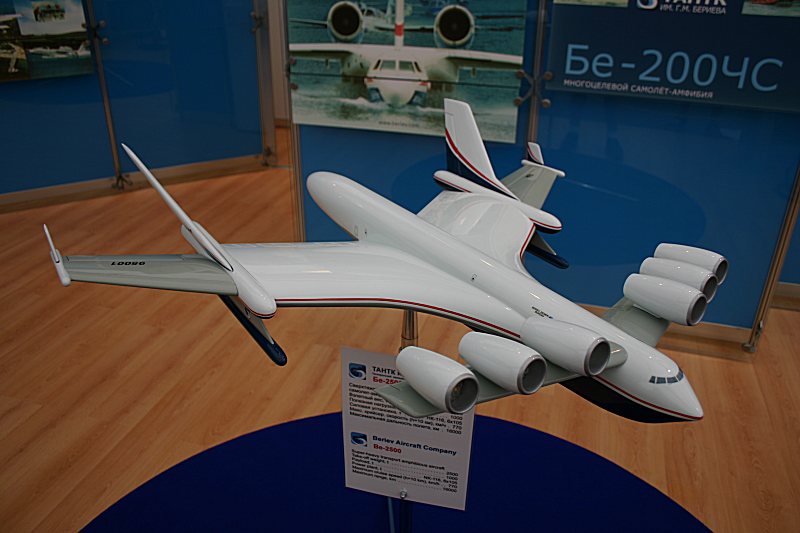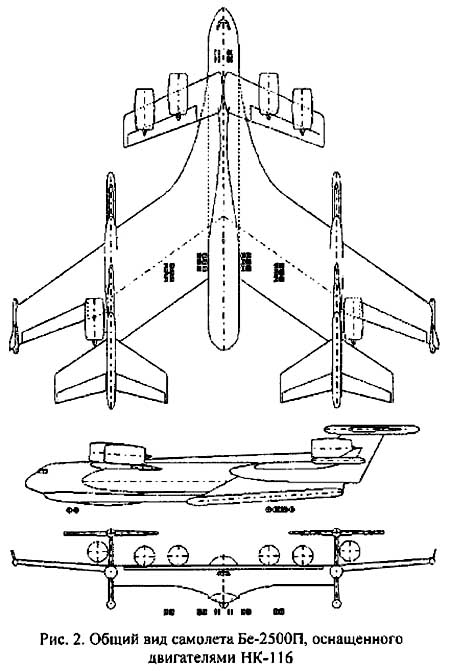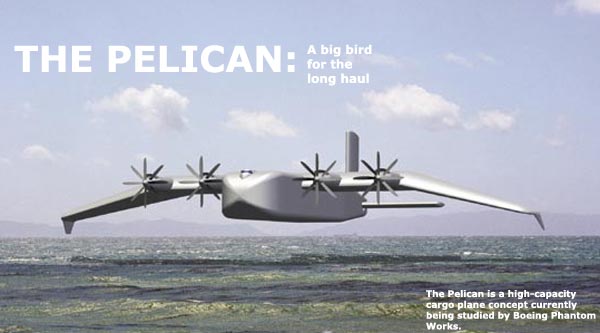
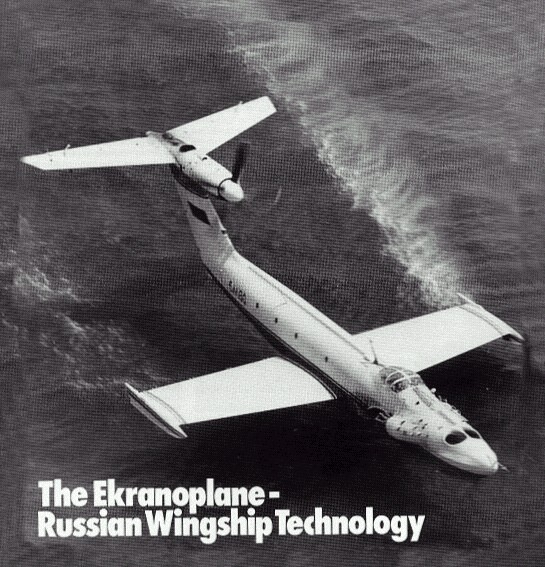
Build a 1:144,000 scale model of a Russian WIg
Getting More Strategic Lift: Wing-In-Ground Effect Craft


Build a 1:144,000 scale model of a Russian WIg
It's becoming increasingly clear, that America's military bureaucracies are bent on paths leading to the future destruction of our nation's men and women in uniform as well our economic prosperity by ill-conceived war rackets that deliberately prolong wars--instead of smothering conflicts and winning them with moral and efficient outcomes. One of the fatal dangers of keeping your enemies in play is that they get a chance to learn, and they might just come back to knock YOU out. Wars should not be trifled with for bureaucratic and corporation profits and budgets.
The Air Force Consequence of the Army Not Having its Own Strategic Mobility: The 1985 Gander Crash Tragedy
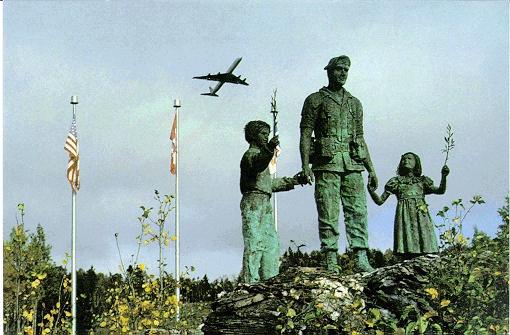
This reality smacks-you-in-the-face, when you meet a still-greiving relative of one of the U.S. Army Soldiers of the 101st Airborne (Air Assault) Division who were returning from Sinai peacekeeping duty but who died in the civilian contract DC-8 crash at Gander, Canada in 1985. The question has to be asked:
WHY IN THE HELL WERE U.S. ARMY SOLDIERS FLYING IN FLIMSY CIVILIAN TUBE & WING AIRLINERS AND NOT IN U.S. AIR FORCE TRANSPORT PLANES WEARING PARACHUTES TO BAIL-OUT IF NECESSARY? USAF PLANES THAT COULD SAFELY CARRY AN ARMY SOLDIER AND ALL HIS WEIGHT--NOT A FLIMSY, THIN-WING, TUBE & WING CIVILIAN PASSENGER PLANE!
qmfound.com/gander.html
The Canadian Air Safety Board's (CASB) extensive investigation of the crash of Arrow flight 1285 in not expected to be completed until early 1987. Preliminary finding indicate that the crash was likely caused by the unfortunate confluence of a number of factors, no one of which would have been sufficient to bring the plane down. These include icing on the wings, mechanical problems and crew fatigue. Overweight conditions in the passenger compartment due to the large amount of carry-on luggage may also be a factor. Passenger and carry-on luggage weight was not determined prior to take-off at Cairo, but the Arrow flight crew had estimated that the average weight per passenger, including carry-on luggage was 170 pounds. CASB calculations indicated that the average weight per passenger with carry-on luggage was at least 220 pounds.The implication to safety of the wide variance between estimated and actual passenger weights led the NTSB to recommend, in February 1986, that the Department of Defense:
"Develop a standard procedure and form for determining an d documenting the actual weights of passengers, baggage, and cargo for the purpose of recording and conveying such weights to the flight crews of commercial contract carriers of military personnel."
Prompted by the NTSB recommendation, the Military Airlift Command issued interim weight criteria guidance for charter flights. A "DOD Passenger Airline Policies Review" issued in April 1986 confirmed the MAC action and proposed strong corrective measures for charter procedures employed by DOD, improved communications between DOD and agencies responsible for aviation safety, and additional resources for the FAA so that it could carry out more effectively its oversight of air carriers.
Notice the typical DoD BS is to paper-over a PHYSICAL PROBLEM with a procedure--in this case WEIGHING EVERY SOLDIER AND HIS GEAR--load & balancing that is routinely done on MILITARY PLANES with LARGE WINGS. Even these planes are not as sound as Burnelli lifting body designs that don't need high take-off and landing speeds in order to create lift over thin wings, and are inherently more crash-worthy.
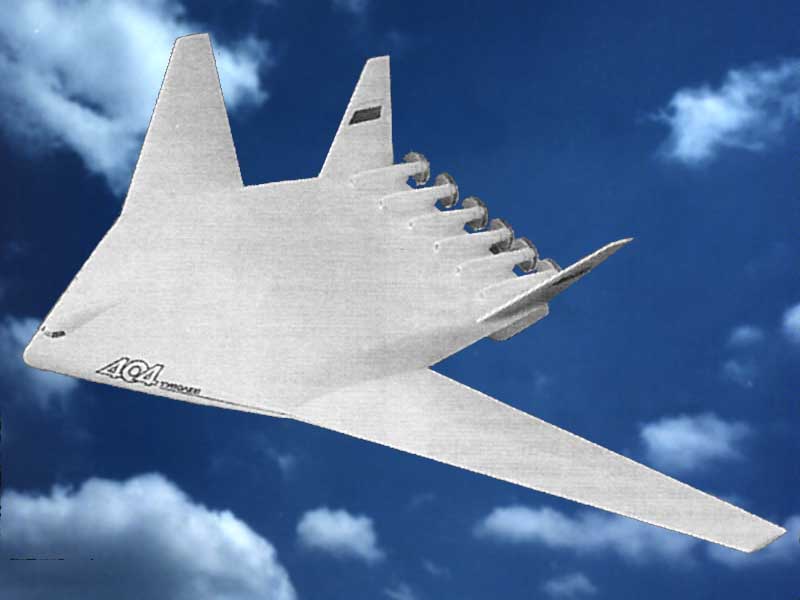
The ugly truth is that since the disastrous 1947 National Security Act creating the self-centered U.S. Air Force (USAF) that tries to win wars all by air-delivered firepower, centralizing ALL air power functions into one egotistic bureaucracy in love with the thin-wing, unarmored jet fighter-bomber trying to do everything has resulted in transport resupply of American ground forces being criminally neglected. We still do not have transport planes that can deliver cargoes without break-bulk using pods/containers, nor transports that can land anywhere via air cushions. The USAF's actual motive for operating its transports is so they can DEPLOY THEIR FIGHTER-BOMBER SQUADRONS to do airpower FIREPOWER bombardment--delivering the Army to do MANEUVER--though done well by the air crews themselves using parachute assault and airdrop is only done as a token bone to con Congress that they are doing all missions, when the reality is that all other air power functions suffer if fighter-bombers are at the top of a pyramid of ego. USAF transport crews though heroic are considered feces lesser life-forms compared to fighter-bomber jocks because the former don't pull high Gs in aerobatics ie; they are not sexy enough.
Fast forward to 1985.
Budgets being cut by the typical guns vs. butter, Rothschild DemoSocialists vs. Rockefeller RepubloNazis political flip-flop, the USAF simply doesn't have the compulsion to fly Army Soldiers to and from the Sinai buffer zone that keeps Egypt and Israel from warring with eachother [MANEUVER FUNCTION] and dragging the entire world into a nuclear World War 3 that almost happened a decade before in the 1973 Yom Kippur War, so the Army has to hire commercial airliners of dubious safety qualities to fly our troops. Result is over 250+ dead Soldiers--murdered indirectly by the USAF bureaucracy.
This web page will explore how the U.S. Army must get its own strategic mobility by owning and operating its own Wing-In-Ground (WIG) effect seaplanes so tragedies like Gander never happen again. Other important capabilities like Cargo 747s, FastShips and Hybrid Ligther-Than-Air (LTA) craft are covered on their own web pages (click on their hyperlinks for details).
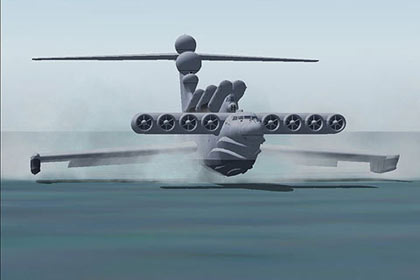 James Bond 007 Bloodstone Epic Battle vs. WIG
James Bond 007 Bloodstone Epic Battle vs. WIG
 youtube.com/watch?v=-WkbHefNoWU
youtube.com/watch?v=-WkbHefNoWU
boeing.com/news/frontiers/i_pw.html
BY WILLIAM COLEIt would be the biggest bird in the history of aviation.
Dwarfing all previous flying giants, the Pelican, a high-capacity cargo plane concept currently being studied by Boeing Phantom Works, would stretch more than the length of a U.S. football field and have a wingspan of 500 feet and a wing area of more than an acre. It would have almost twice the external dimensions of the world's current largest aircraft, the Russian An-225, and could transport five times its payload, up to 1,400 tons of cargo.
Designed primarily for long-range, transoceanic transport, the Pelican would fly as low as 20 feet above the sea, taking advantage of an aerodynamic phenomenon that reduces drag and fuel burn. Over land, it would fly at altitudes of 20,000 feet or higher. Operating only from ordinary paved runways, the Pelican would use 38 fuselage-mounted landing gears with a total of 76 tires to distribute its weight.
The military, commercial and even space prospects for such a cargo plane-officially known as the Pelican Ultra Large Transport Aircraft, or ULTRA-are also huge.
"The Pelican can broaden the range of missions for which airplanes are the favored way to deliver cargo," said Boeing's Pelican program manager Blaine Rawdon, who is designing the plane with Boeing engineer Zachary Hoisington. "It is much faster than ships at a fraction of the operational cost of current airplanes. This will be attractive to commercial and military operators who desire speed, worldwide range and high throughput. We envision that the Pelican can multiply aircraft's 1-percent share in a commercial market now dominated by container ships."
John Skorupa, senior manager of strategic development for Boeing Advanced Airlift and Tankers, said, "The Pelican currently stands as the only identified means by which the U.S. Army can achieve its deployment transformation goals of deploying one division in five days, or five divisions in 30 days, anywhere in the world." If necessary, he said, the Pelican could carry 17 x M1 Abrams main battle tanks on a single sortie. Commercially, the aircraft's size and efficiency would allow it to carry types of cargo equivalent to those carried by container ships, at more than 10 times the speed.
"It is attracting interest as a mother ship for unmanned vehicles, enabling rapid deployment of a network-centric warfare grid, a likely future mode of operation for modernized U.S. forces as demonstrated in Afghanistan," Skorupa said. "And it is attracting interest as a potential first-stage platform for piggybacking reusable space vehicles to an appropriate launch altitude.
Why would such a huge airplane be flown at such a low altitude?
By flying low, the Pelican, like its name-sake, exploits the aerodynamic benefits of a well-known phenomenon called ground effect. Flying close to water, the wing downwash angle and tip vortices are suppressed, resulting in a major drag reduction and outstanding cruise efficiency.
"It's an effect that provides extraordinary range and efficiency," Skorupa said. "With a payload of 1.5 million pounds, the Pelican could fly 10,000 nautical miles over water and 6,500 nautical miles over land."
"Flying in ground effect demands the latest flight control technology, conceded Skorupa. Reliable systems will provide precise, automatic altitude control and collision avoidance. Cruise altitude will be adjusted according to sea state, and if the seas get too rough, the Pelican can easily climb to high altitude to continue the flight."
When could the Pelican be flying? The answer may lie in the Army's Advanced Mobility Concepts Study, scheduled for release next April. The Pelican has been offered by Boeing as part of a system-of-systems solution that would include the C-17 Globemaster III transport, the CH-47 Chinook helicopter and the Advanced Theater Transport.
"A favorable report would set the stage for a possible codevelopment effort between Boeing, the U.S. military and interested commercial cargo carriers," Skorupa said.
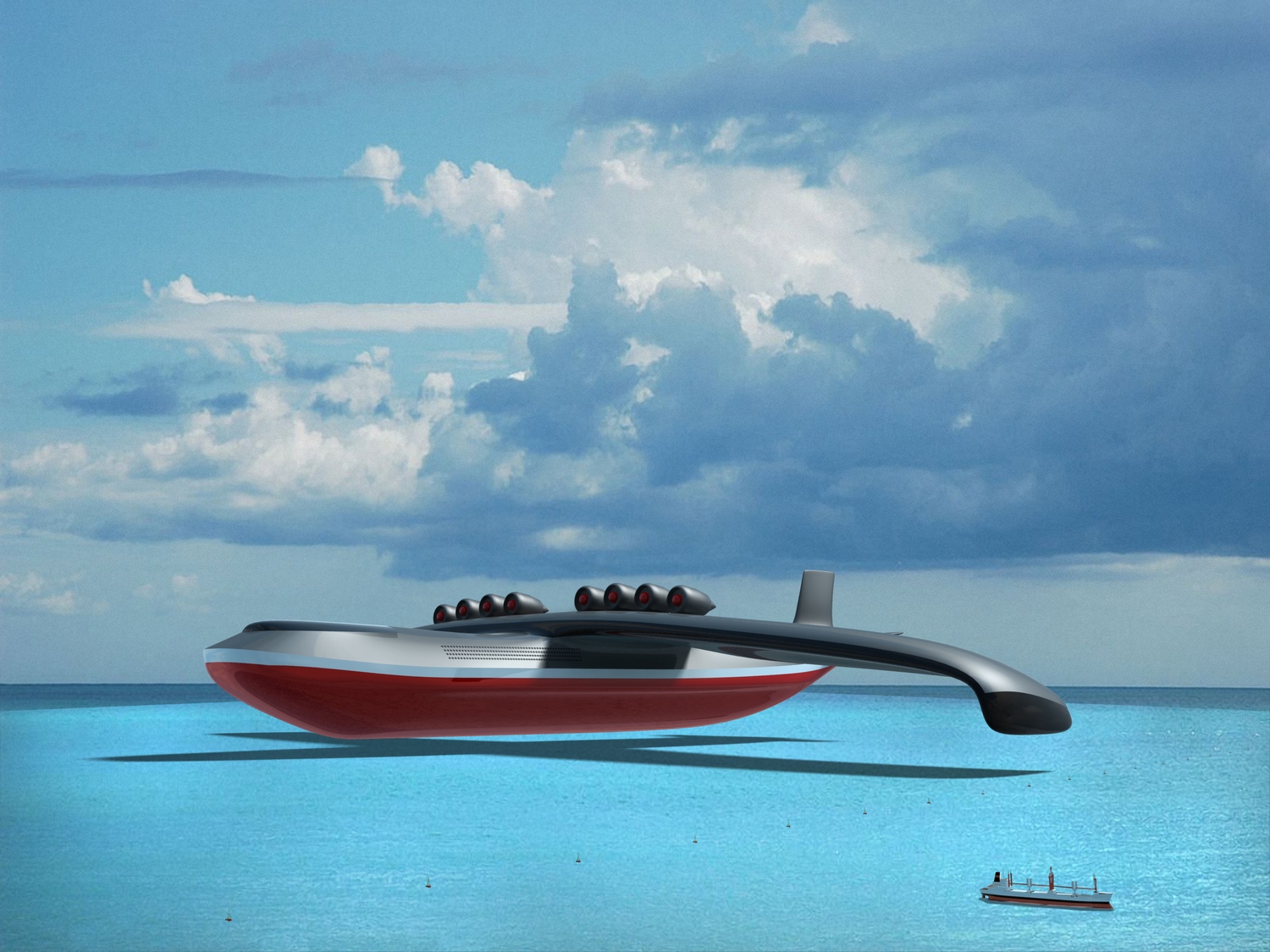
London Sunday Telegraph
October 6, 2002Biggest-Ever Plane Will Carry An Army
By Peter Almond and Sean Rayment
Boeing, the American defence company, plans to build the world's largest aircraft, capable of delivering a fleet of battle tanks directly into a war zone.
The aircraft, which has been named the Pelican, will have a wingspan of more than 500ft and a wing area of one acre. A Boeing 747 has a wingspan of 195ft.
Aeronautical engineers claim that it will be able to fly 14,000 tons of cargo more than 10,000 miles. The Pelican will be designed to fly 50 feet above the ocean, using the buoyant aerodynamic effect of flying close to the water to provide its maximum economic range.
United States defence chiefs believe that a fleet of Pelicans will enable them to deliver thousands of troops, tanks and aid anywhere in the world in a fraction of the time presently taken by cargo ships.
The Pelican has the capacity to carry up to 17 main battle tanks, which each weigh more than 50 tons. The largest military cargo aircraft in service at present is the Russian Antonov 225, which has a range of 2,800 miles. The Pelican would land and take off on civilian or military runways like a conventional aircraft but it has up to 38 sets of landing gear and 76 tyres to spread the weight more evenly.
Powered by four advanced turboprop engines, it would be capable of cruising over land at up to 20,000ft, although its maximum effectiveness would be over water. Blaine Rawdon, the Pelican project manager, said: "It will be much faster than ships at a fraction of the operational cost of commercial aeroplanes. The ultra-large transport aircraft will be attractive to commercial and military operators that require speed. It will compete with container ships."
The aircraft will evoke memories of the gigantic H-4 Hercules Spruce Goose seaplane designed during the Second World War by Howard Hughes, the reclusive billionaire American industrialist and film producer. Mr Hughes built the H-4 after the U.S. war department lost interest in a plan for a flying boat that would carry bulky cargoes or up to 700 troops alongside the "Liberty Ships" that were turned out rapidly to move supplies to Britain and elsewhere during the Second World War.
In November 1947, the wooden eight-engined aircraft finally hopped a mile across the harbour at Long Beach, California, at a height of 70 feet watched by thousands of spectators. It never flew again.
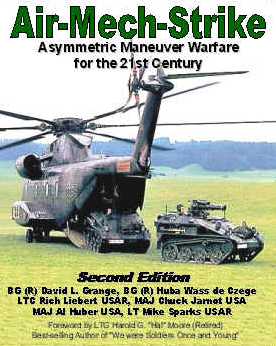
Excerpt from Chapter 11 of our book, "Air-Mech-Strike: Asymmetric Maneuver Warfare for the 21st Century", first edition published in 2000:
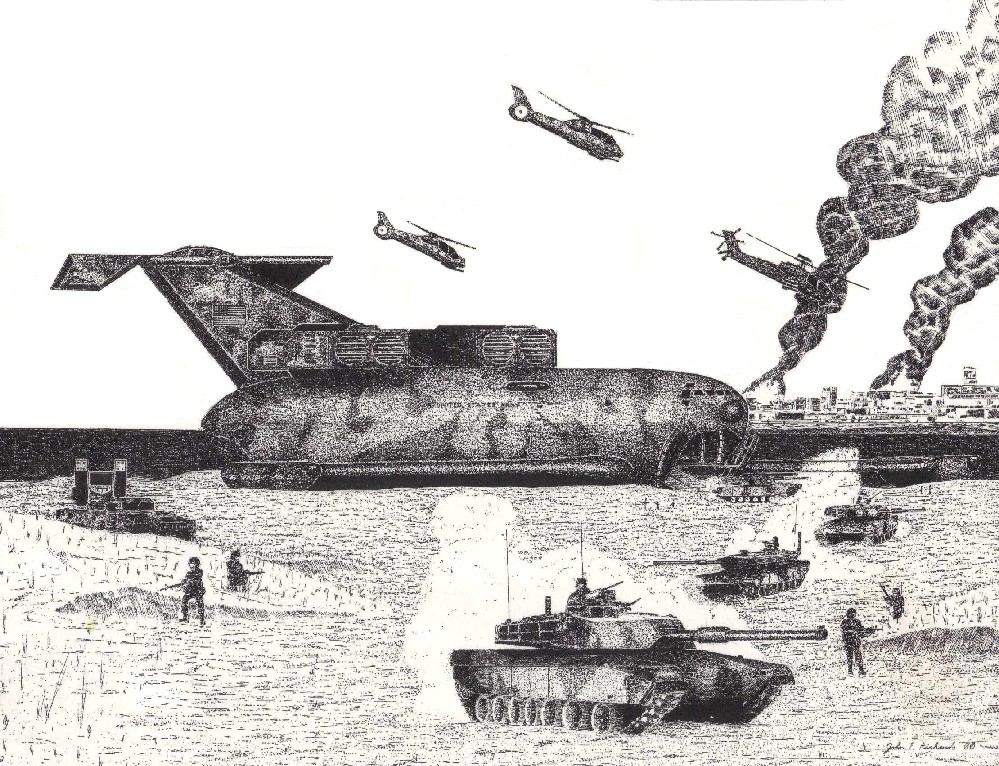
The strength of the Air-Mech-Strike concept is that it puts together the absolute best combined-arms weapons together and doesn't compromise to just one type arm or one type platform. Its an optimized force structure that concentrates on just a few capable platform types and arranges them into packages that are deployable by available strategic and tactical lift. However, its implied that it would be wise to get more strategic lift in order to get the heavy 2D forces in the Phalanx Force to the battlefield as quick as the lighter 3D forces that are better sized for air transport; expecting these forces to work together in their unique ways later on.
United States military strategy is based on certain explicit assumptions, which influence the environment in which the Army will operate over the next decade. These include a defensive strategy during which the U.S. Army will reshape, train and respond to missions. With the end of the Cold War, the threat of a global war receded and debate resumed whether the United States needs to continue to prepare to fight two major theater wars simultaneously. No major peer competitors should emerge over the next two decades; however, the emergence of a coalition of states hostile to the United States could emerge as a threat by the end of the decade. The most probable threats to U. S. national interests that are likely to come will be from failed states, transnational actors and competitors for resources. The United States Army will find itself fulfilling a wide range of missions throughout the globe. The bulk of its forces will be stationed within the United States, but they will deploy on force-projection missions. In this regard, the United States Army has a marked interest in overcoming the "tyranny of time and distance" by first organizing itself for 3-Dimensional maneuver on the battlefield with Air-Mech-Strike and by improving its deployment mobility means. As USAF General Walter Kross, CINC Transportation Command, pointed out, while aircraft may deploy some forces and their equipment to distant theaters, sealift will continue to be vital since "95 percent of dry cargo and 99 percent of liquid cargo will likely move by sea."6 In no other theater is the tyranny of time and distance so evident as that in the Pacific. As Admiral Dennis C. Blair, U.S.Navy Commander in Chief, U.S. Pacific Command, noted during his testimony before the House Armed Services Committee (March 1999), fostering a more secure Asia-Pacific region remains the primary goal of PACOM and that "deployed, ready, and powerful Pacific Command forces" are the best foundations for the region's security and development.7 Pre-positioned stocks and forward deployed forces are the first echelon of American engagement and security in the region, but only linkage to strategic forces in the continental United States can insure the nation's ability to sustain commitments and engage in effective compellence. There is an older Air-Mech technology that, while no "silver bullet", could assist the United States Army in performing its power projection missions in the Asia-Pacific area and other regions of the globe.
The Tyranny of Time and Distance in the Pacific: One Hundred Years and continuing
In 1998, the United States Army marked a century of engagement in the Pacific and Far East. In that century, the Army proved a key factor in American forward presence and power projection during peace and war. Its presence was necessary to deter conflicts, work with allies and friendly states, support humanitarian assistance, and win the nation's wars in this vast region. This year, Americans will mark the fiftieth anniversary of the beginning of the Korean War. Korean War historian and U.S. Army combat veteran, T. R. Fehrenbach observed:
Americans in 1950 rediscovered something that since Hiroshima they had forgotten: you may fly over a land forever; you may bomb it, atomize it, pulverize it, and wipe it clean of life, but if you desire to defend it, protect it, and keep it for civilization, you must do this on the ground the way the Roman legions did, by putting your young men into the mud.
A century of the U. S. Army engagement in Asia began with the Spanish-American War. U.S. naval power might destroy Spain's Pacific Squadron but it could not occupy and hold the Philippines. There was a long delay between Dewey's victory at Manila Bay on 30 April 1898 and the eventual arrival of an U. S. Army force in the Philippine Islands--there certainly were no Air-Mech-Strike capabilities available then. This delay created a political-military sovereignty gap and allowed an insurrection to grow which opposed incorporation into the United States. The first of three contingents from Major General Wesley Merritt's Philippines Expedition left San Francisco on 25 May and arrived in Manila on 30 June; the last contingent arrived on 25 July. 9 This delay in the arrival of the expedition allowed Emilio Aguinaldo, a Filipino nationalist, to begin an armed struggle for national independence. This struggle led to a full-fledged insurgency against American rule, which was not completely suppressed until 1902. While the role of the United States and its Army in the Asia-Pacific region has changed over that century, the continuing tyranny of time and distance in the Asian-Pacific area still dominates strategic plans and concepts due to our dependence on sea-lift. By World War II, sailing times had only been slightly reduced, since even today it still requires 21 days to move troops, equipment, and supplies by sea from Oakland to Manila and 16 more to reach the western limits of the PACOM and USARPAC Area Of Responsibility (AOR) in the Indian Ocean. A recent report by Secretary of Defense William Cohen observed, air movement times across the Pacific are measured in hours, but sailing times still reflect "the tyranny of distance -- 19 days from Seattle to Thailand, 18 days from Alaska to Australia, and 10 days from Hawaii to Korea." Pre-positioning materiel, a Cold-War era solution, arose out of shared threat perceptions and alliance arrangements that developed during that era. They mitigate but do not overcome the tyranny of distance and are dependent upon the continuation of those shared interests at a time of dynamic changes in the Asia-Pacific security environment. The Revolution in Military Affairs--primary an advance in mental not physical advantages--has yet to conquer the tyranny of time and distance for U.S. ground forces that must deploy from the continental United States to the far reaches of PACOM's area of responsibility, an Air-Mech solution can if its enhanced to bring over large amounts of vital equipment and supplies.
The United State's engagement in the Asia-Pacific region divides into two epochs and an epilogue. That experience demonstrates how vital U.S. Army presence has been in providing regional stability and protecting American interests. The first epoch was dominated by a rivalry between Japan and the United States. China was weak and divided. Russia was unable to defend her Far East. The epoch began with the Sino-Japanese War of 1894 and ended in 1945 with the Japanese surrender on the battleship Missouri in Tokyo Bay.
In that half century, the Navy was the center of gravity of U. S. Pacific military power. U.S. War Plan "Orange" (War with Japan) reflected this geo-strategic calculus. The Army's primary role until Pearl Harbor was to defend the Philippines. The Philippines was far from the continental United States and very close to the Japanese Empire. The American defense ended tragically on Bataan/Corregidor in early 1942. It was the worst defeat of American forces during the entire Second World War--though their gallant stand bought months of time for U.S. forces to mobilize--perhaps the critical action that won the war. In modern conflicts we will not have the time to convert industry from "butter to guns". It was the United States Navy's inability to reinforce the Philippines, after the disaster at Pearl Harbor which sunk much of the fleet unexpectedly by air strikes, that condemned the American and Filipino defenders to an uneven struggle. There is a distinct possibility with space targeting and the proliferation of guided missiles, mines and stealthy diesel-electric submarines that sea-based resupply of far-flung Army units in the Pacific may be interdicted long enough for an aggressor to conquer his neighbor.
WW2 RetroTHINK 2012: The Navy Consequence of the Army Not Having its Own Strategic Mobility: The Bataan Death March
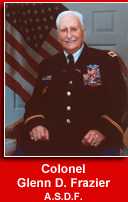 Recently, the AMS-SG had the opportunity to meet a living legend--Colonel Glenn D. Frazier--who at 88 is one of the last living survivors of the infamous 1942 Bataan "Death March" inflicted upon the gallant defenders when their supplies ran out due to U.S. Navy refusal to be prepared to resupply American ground forces by naval means--an incompetence that continues to the present day--that invites another similar disaster to take place again. You can read the horrors these men had to endure in his book below--all because the narcissistic U.S. Navy only wants to duel mirror images of itself in fleet actions.
Recently, the AMS-SG had the opportunity to meet a living legend--Colonel Glenn D. Frazier--who at 88 is one of the last living survivors of the infamous 1942 Bataan "Death March" inflicted upon the gallant defenders when their supplies ran out due to U.S. Navy refusal to be prepared to resupply American ground forces by naval means--an incompetence that continues to the present day--that invites another similar disaster to take place again. You can read the horrors these men had to endure in his book below--all because the narcissistic U.S. Navy only wants to duel mirror images of itself in fleet actions.
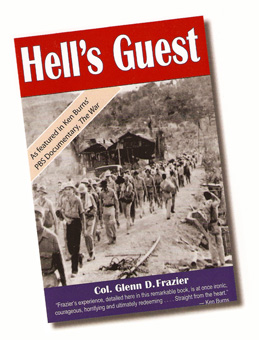
Now consider this.
Imagine that instead of being obsessed with aircraft carriers to duel other fleets, the U.S. Navy had large transport submarines and hundreds of heavily armored, heavily armed with seaplane fighters and anti-aircraft weaponry FAST CARGO SHIPS that would instead of pulling up to a pier and being a sitting duck target breaking supplies into slow crane loads, would beach their bows onto the sand and roll-off thousands of cargo containers. Remember the LSTs? Imagine a Navy with hundreds of large Mars seaplanes that could operate by tender ships and resupply Army troops even if the enemy navy controls the sea...
MacArthur's Soldiers with some live-off-the-land skills and an ability to steal the Japanese enemy's weapons and ammunition to use against them--hold out indefinitely. As his forces get stronger, the Japanese are evicted from the Philipines with an influx of fresh American troops and light tanks. BY THE END OF 1942, AMERICAN B-24 HEAVY BOMBERS ARE SETTING JAPANESE PAPER & WOOD CITIES AFLAME. The Japanese home islands are bottled up by sea mines layed by our submarines and bombers. Sorry, no aircraft carrier glory for the Naval bureaucrats to spin about---just WW2 in the Pacific over by 1944--SAVING THOUSANDS OF LIVES. General Eisenhower in his 1947 book, Crusade in Europe clearly states that the Philipines could have and should have been resupplied--but were not due to U.S. Navy incompetence--with tragic concequences.
Enough is enough. If the U.S. Army is America's largest military service, its high time it start acting like it. Beginning with pre-positioned cargo 747s converted from airliners sitting unused in the desert because they are not economical to operate daily, Congress should reform the disastrous 1947 National Security Act and by force of law create a new Army Air Corps that would not only operate the cargo 747s but a fleet of transport seaplanes the Navy is no longer interested in operating, so it can have it's OWN STRATEGIC MOBILITY. In this way, even if the Navy and the Air Force botch control of the sea and air due to their tendancies to go off on narcissistic tangents, America's Soldiers will not be abandoned again to fight the enemy without supplies, so at least our ability to hold and maneuver on the ground is never lost.
During WWII there was time to rebound and the newly equipped American counter-offensive, using both naval and air power proved the decisive instruments in carrying the war across the Pacific. These forces made possible the deployment of U.S. Army and marine forces in Airborne and Amphibious advances across the Southwest and Central Pacific Theaters. On the verge of the invasion of the Japanese home islands, President Truman decided to avoid inevitable large-scale casualties and employed atomic weapons to force the Japanese government's surrender. Thereafter, nuclear weapons would be a primary factor in the U.S. military presence in Asia and an ingredient in the management and resolution of Asian security issues.
In 1947, the United States granted the Philippines their independence, after securing a naval and air basing agreement with the elected Philippine government. The U. S. supported another counter-insurgency struggle in the Philippines, this time successfully conducted by the Philippines' government against the Hukbalahap communist guerillas. The second half of the century, and second Pacific epoch, was dominated by the Cold War confrontation between the United States and the Soviet Union. This confrontation took on strategic dimensions in the Pacific with the triumph of communism in China, the detonation of the first Soviet atomic bomb, the signing of the U.S.-Japanese Peace Treaty, and the North Korean invasion (with Soviet support) of South Korea. The Cold War was cold in Europe but hot in Asia. Politically, the broad outlines of U. S. Pacific presence were forged by the end of the Korean War. After air-deployed forces from Japan stabilized the front, reinforcements poured in. One of the central problems in the initial period of the Korean war was the timely deployment time of forces from the continental United States to stabilize the defense and to create a strategic reserve to regain the operational-strategic initiative. Its been said that this "policy war" or "police action" was "the wrong war, in the wrong place, at the wrong time". But the United States Army found itself committed to a full-blown war with an intractable opponent half a world away. A negotiated settlement and not military victory defined the end of the contest and many strategic planners were quite certain that future wars would be won by air power and "massive retaliation." There would be a military forward presence on the Korea Peninsula, in the Taiwan Straits, and across Southeast Asia as "trip-wire" forces for this "massive retaliation". The U.S. deployed a large military infrastructure in Asia, especially in the Philippines and Japan. In 1964, in the context of deteriorating Sino-Soviet relations, the PRC tested its first nuclear weapon. At the same time, the United States assumed the burden of opposing Vietnamese communism following the French defeat there. That commitment, which began as assistance to the South Vietnamese counter-insurgency effort, became America's largest and longest war of the Cold War era. A combination of perpetual air and sealift continued the fight but U.S. forces were always out-numbered, unable to mass the force size required to pacify the South with a defensive strategy nor the Air-Mech transportation means to quickly mass enough force to invade and subdue the North had that option been pursued.
American withdrawal from Vietnam and the defeat of the South Vietnamese regime led to a new phase of the Cold War in Asia after 1975. Korea remained stable, thanks to on-the-ground U.S. military presence and the economic transformation of the South. Japan became a truly global economic power. Southeast Asia witnessed a series of economic miracles. The U.S. opened relations with China. In this geopolitical context, the United States' rapprochement with China leveraged the Cold War to the U.S. advantage. Playing the "China card" became a vital part of the East-West confrontation as detente' gave way to another round of confrontations. China began a market-driven economic transformation although the Chinese Communist Party maintained its political monopoly on power. In the later 1980s and early 1990s, the Cold War ended in Asia with Soviet disengagement, following their domestic crisis and imperial overreach in places like Afghanistan. The U.S. Army in the Pacific played a crucial role in the final victory in the Cold War by providing a credible military deterrence and presence in Asia, especially in Korea.
It is now the end of the first decade of the post-Cold War era. Many changes in the Pacific security environment have transpired and the direction of those changes raise serious questions about the ability of American land power to deploy in a timely and effective fashion into the theater during the twenty-first century. While the United States still retains the use of a vast forward theater infrastructure in Korea and Japan, the new dynamics in the Pacific and Asia raise the prospect of conflict. Instability in Indonesia and the Australian Air-Mech-led multi-national military intervention in East Timor, the explosion of nuclear weapons by India and Pakistan, the recent fighting over Kashmir, China's disputed claims to the Spratley Islands and the growing belligerency of China toward Taiwan point towards the possibility of military conflict in the region.
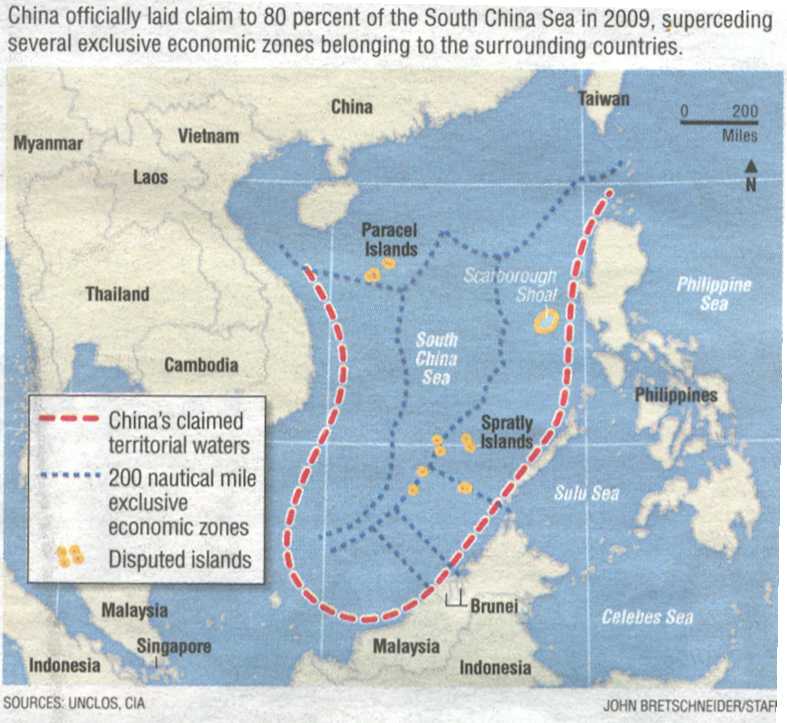
Open discussions of an alliance among Moscow, Beijing, and New Delhi to counter what its architects call "globalism and U.S. hegemony" could well be a harbinger of new tensions in Eurasia. These developments makes it imperative that the United States Army develop Air-Mech-Strike means to overcome the tyranny of time and distance to maintain credible influence as a projected force in this theater. The United States Army cannot deploy and sustain large forces across the Pacific by ships much faster than it did in 1899. Air-Mech means that could expedite movement in the vast Pacific can also expedite deployments from the continental United States to Europe, the Middle East, and the Indian Ocean, by radically shifting the time of deployment over vast distances in crisis situations. Does such an Air-Mech prospect exist and can U.S. military strategy and the United States Army benefit from its realization?
Spotlighting an Air-Mech-Strike Technological Alternative: WIG
Strategic maneuver is an inherent characteristic of the U.S. Navy and U.S. Air Force. Naval presence has been a feature of sea power since the age of sail. As navies grew to where they could "command the sea", they have been able to apply pressure through blockades. Modern naval theory, since Mahan, has viewed the advances of naval technology as enhancing this role. With the end of the Cold War and the decline of its only oceanic contestant for command of the sea, U.S. Chiefs of Naval Operations have championed a new strategic role for the U.S. Navy. This role incorporates precision, deep-strike weapons systems and amphibious capabilities to project power now labeled "Forward from the Sea" as an instrument of coastal, littoral warfare. Air power champions since Douhet, Trenchard, and Mitchell have recognized the decisive influence of command of the air and the deep strike capabilities of Air Forces; some like Mitchell and Kenney have also wanted to air-transport Army ground forces to influence the course and conduct of war farther inland than the littorals. From the flight of the experimental B-15 to Latin America on a humanitarian mission in the 1930s to the advent of modern, nuclear-armed, inter-continental bombers and ballistic missiles, strategic aerospace mobility has been a vital component of United States national strategy, as air-deployed U.S. Army forces have helped to rapidly win conflicts in the Dominican Republic, Grenada, Panama, Haiti, Bosnia and now Kosovo. But these Army forces have been "light " due to airlift constraints and have required reinforcements arriving very slowly by sea or rail.
The Revolution in Military Affairs and the advent of stealth aircraft and deep, precision-strike conventional weapons has given the United States Air Force the capability to exercise "virtual global presence." B-2 strikes launched from Whitman AFB, Missouri against targets in Yugoslavia were a manifestation of this capability. Both the Navy and the Air Force possess the ability to deploy and sustain credible combat capabilities into distant theaters in a timely fashion. Forward infrastructure provides support and sustainment in many regions of the globe. Each service has its own transport that allows it to deploy worldwide. Naval forces give the U.S. marine corps the ability to fight abroad, if nearby or if there is time to set sail to get there. However, the marine corps lacks the critical land power mass/expertise with which to engage far inland strategic maneuver in distant theaters. In contrast, the U.S. Army has the critical mass/experience to conduct such maneuver but lacks the strategic mobility to overcome the "tyranny of time and distance" to back "virtual presence" with actual "boots-on-the-ground" presence that changes governments and gets people to stop fighting and killing each other. Until the United States Army acquires the capability to deploy significant land power into theater in a timely fashion, the United States will not have a truly joint force posture to address the full-spectrum of operations confronting the United States in the post-Cold War world.
With the end of the cold war, the Army changed from a forward-deployed power to a primarily CONUS-based force-projection power. The U.S. Army is dependent on the U.S. Navy and U.S. Air Force to get it to the fight on time. Yet, there have been no sweeping concurrent changes in the transport capability of the U.S. Navy or U.S. Air Force to support this new U.S. Army mission. Therefore, despite the best efforts of the sister services, the full weight of the enormous combat power of the U.S. Army is essentially a not brought to bear quickly in a far-off fast-breaking situation. The Army Chief of Staff, General Eric K. Shinseki, has recognized this problem and has moved to address it. During a time of high OPTEMPO, General Shinseki has articulated a vision for the twenty-first century: "Soldiers on point for the nation transforming this, the most respected Army in the world into a strategically responsive force that is dominant across the full spectrum of operations." He addresses the Army's serious logistics problem:
Today, 90% of our lift requirement is composed of our logistical tail. We are going to attack that condition both through discipline and a systems approach to equipment design. We are looking for future systems which can be strategically deployed by C-17, but also able to fit a C-130-like profile for tactical intra-theater lift. We will look for log support reductions by seeking common platform/common chassis/standard caliber designs by which to reduce our stockpile of repair parts. We will prioritize solutions which optimize smaller, lighter, more lethal, yet more reliable, fuel efficient, more survivable solutions. We will seek technological solutions to our current dilemmas.14
In line with this vision, the Chief of Staff ordered the creation of a test-bed medium Brigade which can rapidly deploy on current navy and air force vessels and aircraft. This Brigade, outfitted with new equipment, should reduce logistics tonnage requirements by 50-70% and allow the Brigade to deploy anywhere in the world in 96 hours. Further, the Army should be able to Air-Mech a Division composed of these Brigades within 120 hours and five Divisions of these type Brigades within 30 days. This may be possible considering current and future air transport requirements. However, there is the problem of building such "medium weight" Brigades from scratch--a costly effort that the Army projects will amount to about 5 Brigades by the end of the current CSA's tenure. Air-Mech-Strike can build medium-weight Brigade Combat Teams much faster and inexpensively than this; transforming the ENTIRE U.S. Army in the same time that only a handful of Brigades can be built from scratch. This would create the forces we need to dominate in peace and in war, but the deployment time of the multi-Divisional force still reflects the "tyranny of time and distance" that has dominated the global reach of land power in the twentieth century, if we cannot provide more "Air" to move the "Mech". The current sea lift requirement, which calls for 36 Roll-On/Roll-Off ships, do not represent an effective increase in deployment speed and require the possession of an operational arrival port. Nor is there much help from the troubled U.S. Merchant Marine.
A 1991 Rand Study noted the decline of U. S. merchant marine dry-cargo ships from 300 to 200 during the 1980s and projected a decline of in military sealift capacity (i.e., the Ready Reserve Force, Fast Sealift Ships, and Maritime Pre-positioned Ships) to 475,000 tons by the year 2010. The study recommended modernizing sealift and making it "fast", but the technologies explored were hardly revolutionary. For conventional hulled vessels the term "fast" meant an increase from 20 knots to 30+ knots. A Surface-Effects-Ship [SES] option under study used a catamaran hull with an air cushion and had a speed of 55 knots, but this design was judged too technologically risky.
It was the tyranny of distance that drove General Lesley McNair to radically recast the robust but ponderous "square" infantry Divisions of World War I into more mobile, leaner triangular Divisions that deployed globally and won victories in the European and Pacific theaters. Deployability, however, involved costs. In order to give his infantry Divisions offensive punch, McNair pooled assets to increase combat power. In order to sustain global deployability, McNair reduced the weight of armored forces by using light tank destroyers and medium tanks. These proved inferior in armor protection and firepower when they met the German Panther and Tiger [heavy] tanks. The trade-off between deployability and combat power was particularly felt in the initial bitter fighting in the Bocage of Normandy. General Shinseki, like General McNair during World War II, faces the problem of making a force projection Air-Mech Army more deployable, more capable of maneuver, more survivable and more lethal. The challenge of the new medium Air-Mech delivered Brigade is to guarantee that it retains crucial combat power, survivability and endurance for decisive maneuver. The most effective way to guarantee that the Brigade's combat power will dominate stability and support operations and, in case of hostilities, will readily prevail is that the Brigade has some heavy forces organic to it and is backed up by its rapid-deployment Division that should follow rapidly in its wake. Both the Air-Mech Brigade and Division (with the exception of parachute deployable units) will rely on the use of airfields/runways for their deployment. Their "Achilles Heel"-- in a crisis is the 30-day delay in the deployment of a Corps to theater. This delay creates incentives for opposing forces to seek to win before the full force can reach the theater and to engage Army forces in terrain that demands manpower and negates high-tech weaponry. In Europe, rail movement greatly facilitated deployment of U.S. Army ground combat power from Western Europe to the Balkan Theater. This indisputable "ace" in the success of IFOR depended on the staging area in Hungary. However, in many theaters, sealift is still the only way to get large Mech forces into theater. This was true during the Gulf War and would certainly be true of any conflict in the Pacific or beyond. This "way" is not guaranteed to even work if interdicted by modern anti-ship weaponry aided by readily available satellite imagery and its certain to arrive no faster than they did at the turn of the Century; in our Icarean world certainly too late.
While the Army experiments with the creation of a lighter, more agile Air-Mech force, there is a comparatively old technology that could solve the Army's dilemma by providing rapid, inexpensive, long-range, heavy- lift capability, which does not require a seaport or an airport in which to take-off or land. This technology can transport Air-Mech-Strike lightened versions of the Army's lethal Heavy Divisions and their logistics so there is no loss of combat power. This technology can transport this potent Air-Mech-Strike force. That technology is Wing-In-Ground (WIG), a proven technology that has been around for 65 years. The Soviet Union experimented with this technology and built a series of Ekranoplans [screen glider] for a wide range of missions. Russia continues to support the development of the Ekranoplan for its own navy, other services, and for foreign sales.
Getting There First, with the Most, on the Cheap
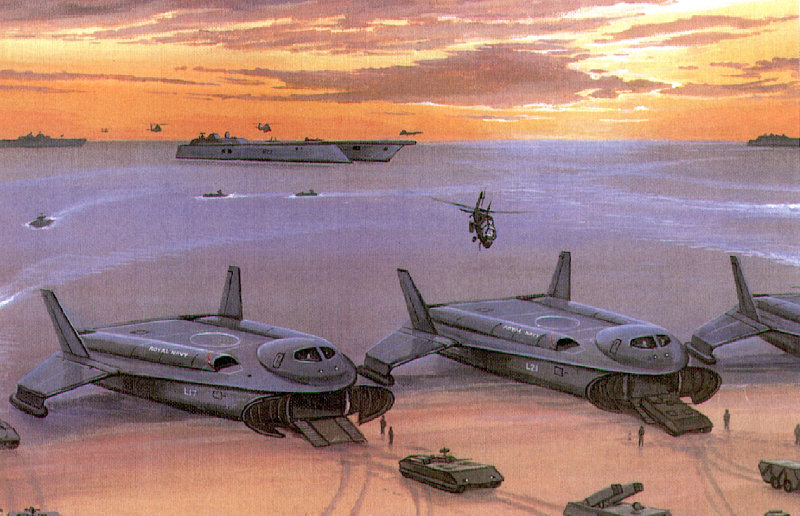
Do you want it there fast or do you want it there cheap? This has always been a concern of manufacturers, merchants and logisticians. When the shipment is trans-oceanic, mile for mile, sea travel is the cheapest. Air shipment is faster, but costs five times more per kilogram of weight. However, WIG technology can deliver large amounts of cargo with significantly less fuel consumption (50% more payload with 35% less fuel consumption than similar-sized aircraft 75% less fuel than comparable-sized hydrofoil ferries). Further, the infrastructure requirements for WIG technology is substantially lower than for aircraft or ships. WIG craft travel nearly as fast as aircraft using much less fuel, they are normally based on a body of water, but can take off and land on ground or water and they do not need a developed airfield or port to function.
The Wing-In-Ground Effect refers to the dense cushion of air that develops between a wing and the water (or ground) surface when they are close together (at low altitude). Sea birds use the WIG effect to skim the water's surface, barely flapping their wings, for hours at a time. Every aircraft experiences the WIG effect as it takes off and lands. Pilots of damaged aircraft conserve energy or use the power of remaining engines more efficiently by dropping down to sea-skimming level to use the WIG effect--although most aircraft are not designed for long-range low-altitude flight. The closer the wing is to the ground (or water), the greater is the amount of lift (and consequently the amount of drag decreases). The larger the WIG Air-Mech craft, the more efficient it is when compared with a smaller craft flying at the same altitude. The Wing-in-Ground effect produces the effect of a much larger wing area without actually increasing wing size.
WIG technology has particular appeal to the military logistician. WIG Air-Mech craft can move heavy loads rapidly across the ocean and land on an undeveloped beach or further inland. It can fly around bad weather. Since it is flying 3-90 feet above the ocean surface, it is hard to detect using radar, infrared or satellite. It can presently fly in excess of 400 miles per hour and carry over 500 short tons.It can fly over water, sand, snow or prairie. It can also fly up to altitude of 3,000 meters, but then it loses its fuel-saving advantages. Russian analysts consider that WIG technology is now at the point where the U.S. can build an ocean-skimming WIG Air-Mech craft. It would weigh 5,000 tons and carry a cargo of 1,500 tons for a distance of 20,000 kilometers (12,420 miles) at a speed of 400 kilometers per hour (250 miles per hour). Such a craft could deliver 1,200 tons of military equipment and cargo plus 2,000 Soldiers. Russian analysts feel that, with financial backing, they could build a 5000-ton craft capable of lifting 1200 tons or 3000 passengers now. It could fly at 800 kilometers per hour (500 miles per hour) with a range of 16,000 kilometers (9936 miles).
WIG Air-Mech craft externally resemble airplanes. They have two huge wings mounted on the hull. The craft uses a turbofan/turboprop or a jet aircraft engine for propulsion. It employs a vertical rudder, horizontal rudder, wing flaps, and a stabilizer to control the craft's heading, and to maintain its flight altitude. Its fuselage and wing structure share aircraft characteristics. Most of it's on board equipment and instruments come from aircraft. Yet, a WIG Air-Mech craft is not an aircraft. An aircraft relies on the flow of air past the wings for the lift needed to fly. A WIG Air-Mech craft uses the ground effect to fly at a low altitude of between 0.8 and 30 meters above the surface of the sea. Most aircraft cannot do this for extended periods of time.
A Bit of History
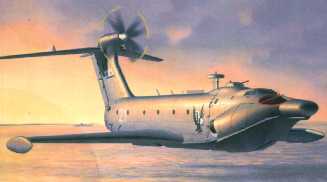
Research on wing-ground-effect began in the 1920s. The first WIG craft were patented in Finland in 1935. T. Kaario, the Finnish engineer built what he called the "wing-ram" craft in that year. The Soviets began building such craft in the late 1950s and gave the prototypes the designation ekranoplan. In 1963, the "Caspian Sea Monster" appeared on the waters of the Soviet Union, (See Figure 2). It was 92 meters (100m yards) long with a 37-meter (40.5 yards) wing span and 22 meters (24 yards) high.
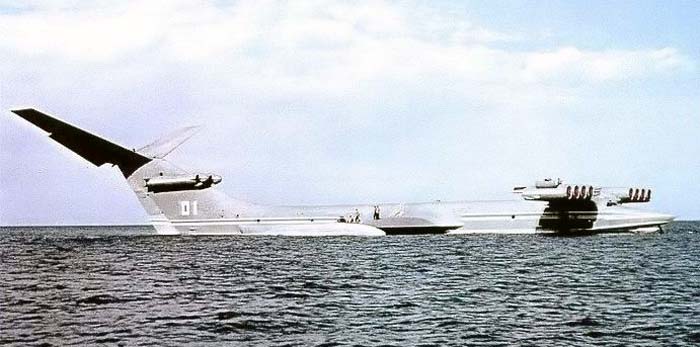
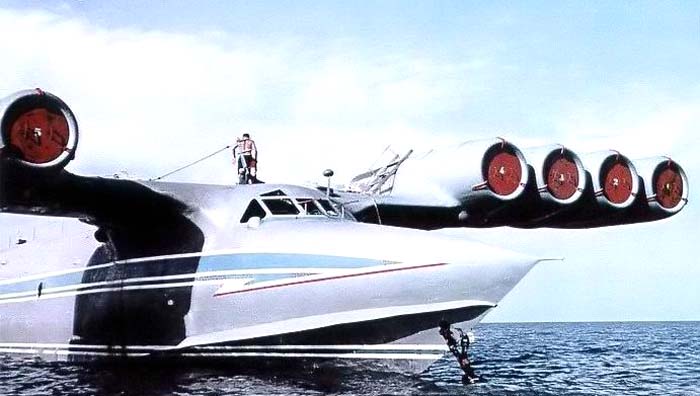
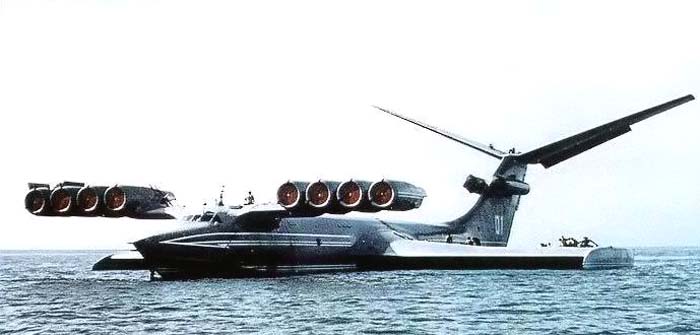
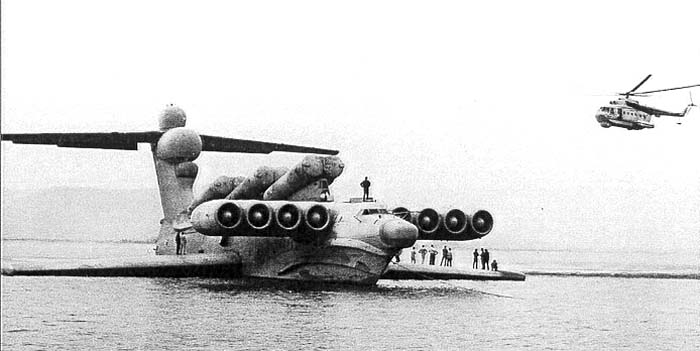
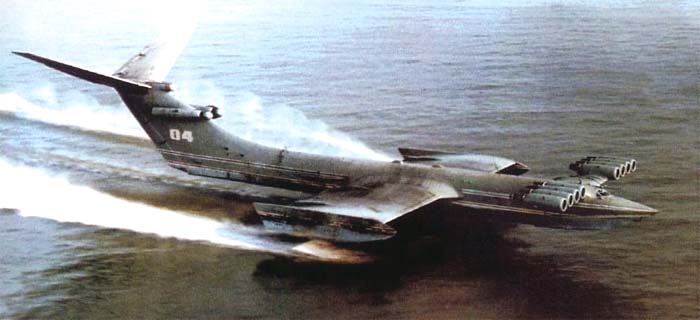
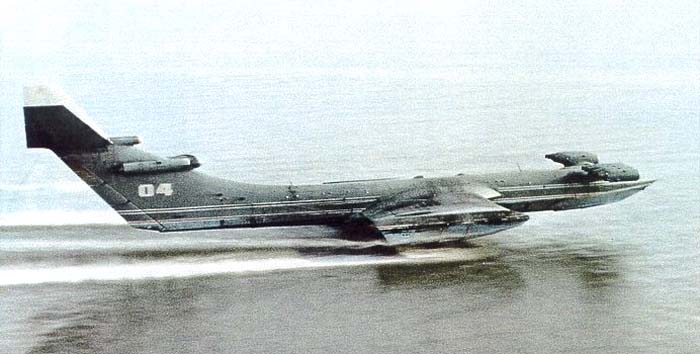
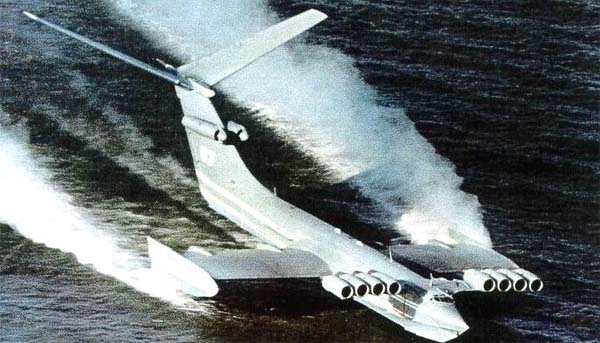
Nicknamed the Korabel Maket [[ship model], it could lift off at 544 tons and cruise at 280 miles per hour. Thirteen 98kN [kiloNewton] turbo-jet engines provided lift and thrust. Eleven of the engines lifted the craft from the water and two provided its cruise power. It took off and landed on water and flew at ten feet above the surface. Due to its shallow draft, it could load and unload in shallow, undeveloped ports.27 This craft crashed in 1980.
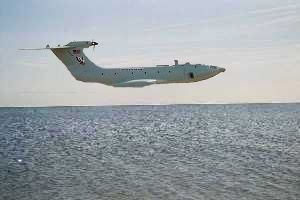
The Soviets went on to build other smaller WIG craft. The first of a planned 120 Orlyonok [Eaglet] appeared in 1972. It was 58 meters (63.5 yards) long, had a wing-span of 31.5 meters (34.5 yards) and a height of 16 meters (17.5 yards). It could lift off at 140 tons and carry 20 tons of cargo. Two 98kN turbofan engines provide the lift while an 11.3 MW turbo-prop engine provided the cruising speed of 217 miles per hour at 6 feet above the water's surface.
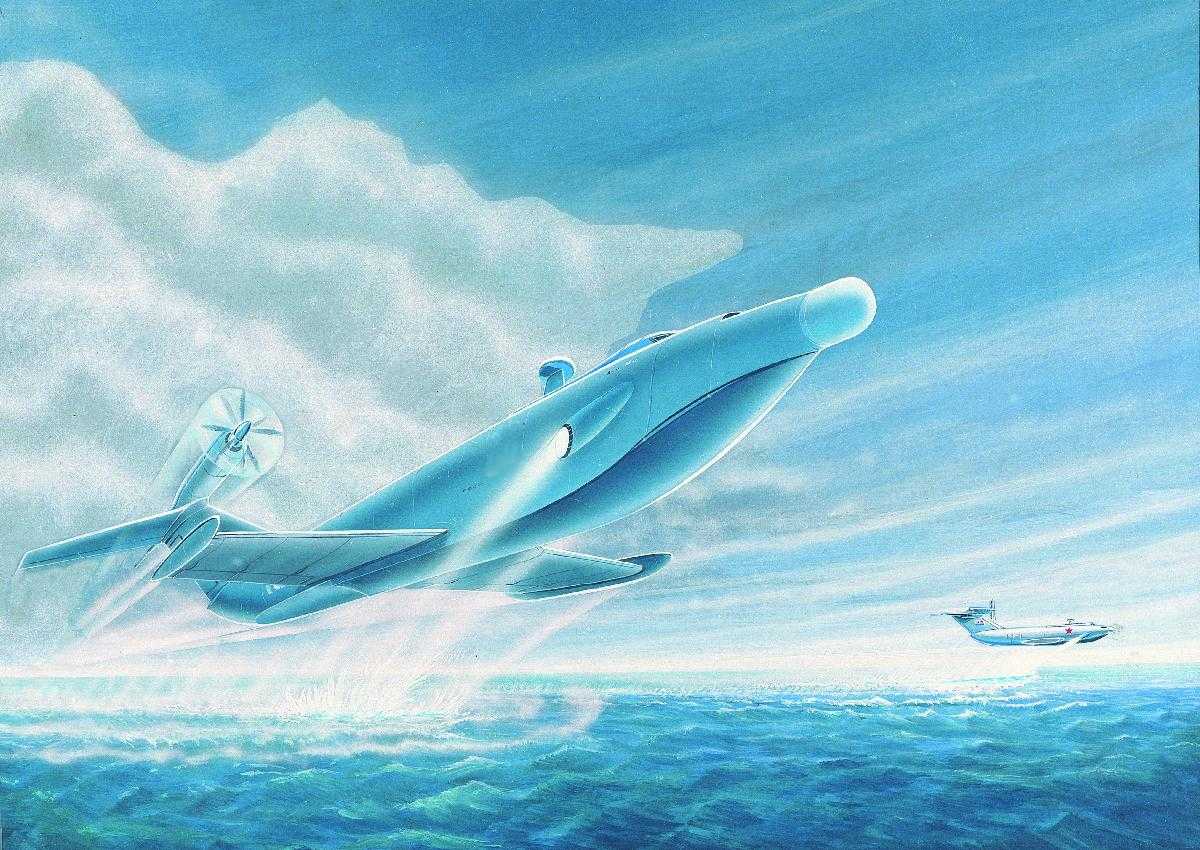
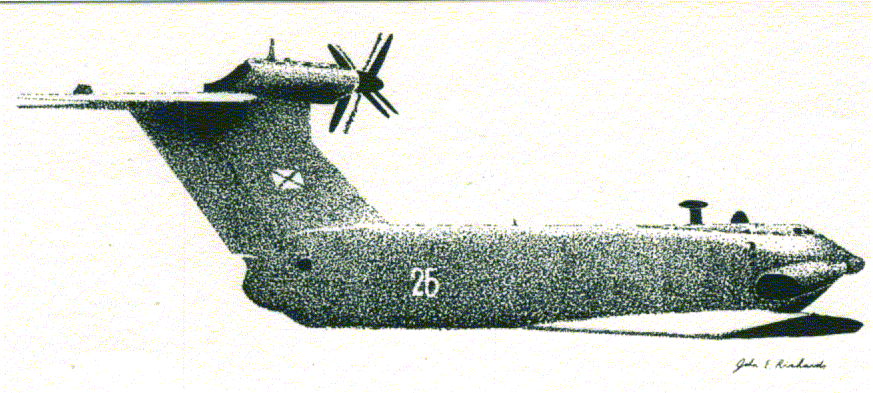
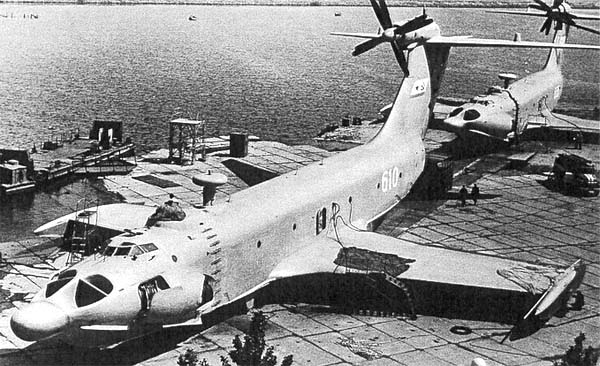
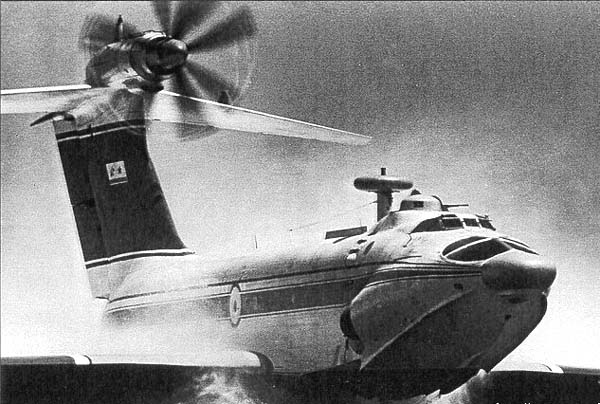
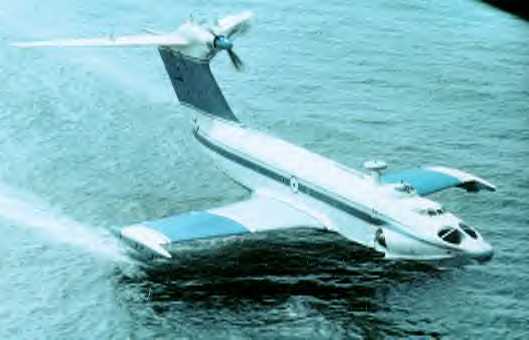
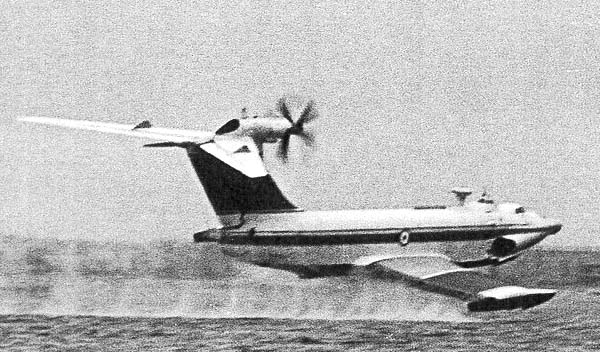
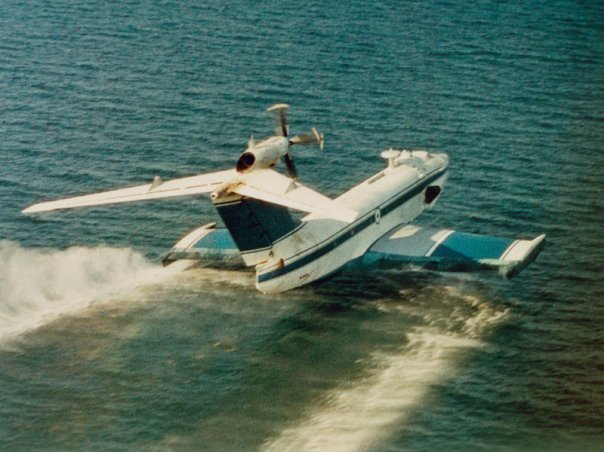
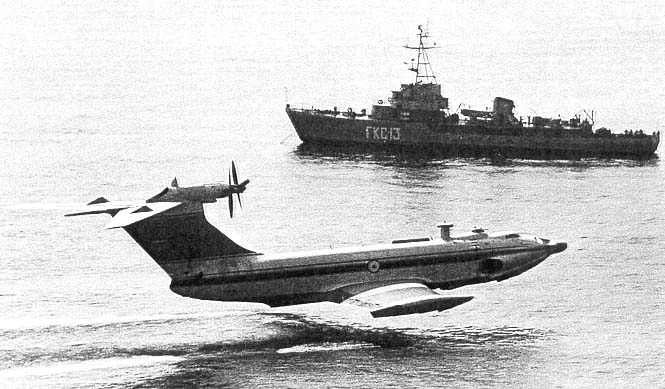
Three of these craft were actually built. The Central Hydrofoil Design Bureau named after R. E. Alekseev, located in Gorky [now Nizhni Novgorod] designed and built the "Lun" [Harrier] and "Spasatel" [Rescuer] WIG craft for the Soviet and Russian Navy. They also built the small Strizh [Martin] WIG trainer craft. At least five other variants of WIG craft were also built. Many of them are still operating safely over the busy waters of the Caspian Sea.
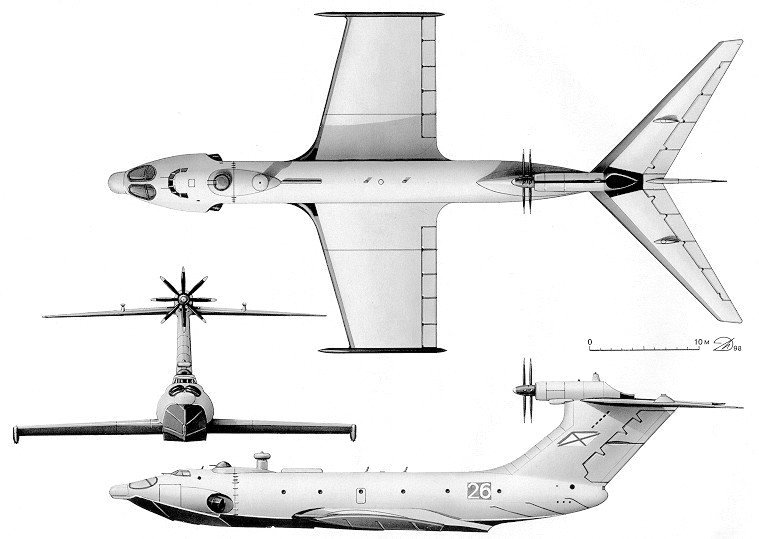


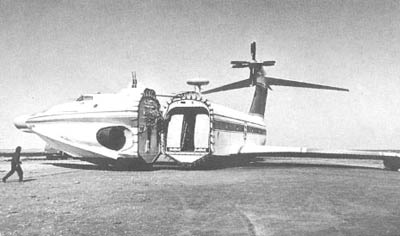
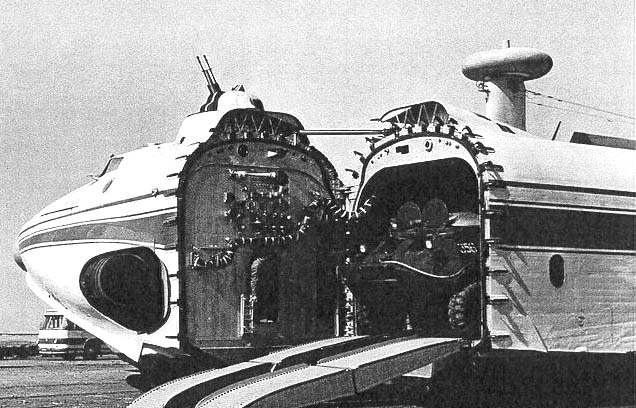
Since the collapse of the Soviet Union, Russia has continued to research, design and produce WIG craft for domestic and international sales. In addition, Great Britain, China, Germany, Finland, Japan, South Korea, Australia, and Montenegro have all conducted WIG craft research and production. The U.S. Air Force considered WIG technology in the 1970s, but built the C-5 that requires runways instead.
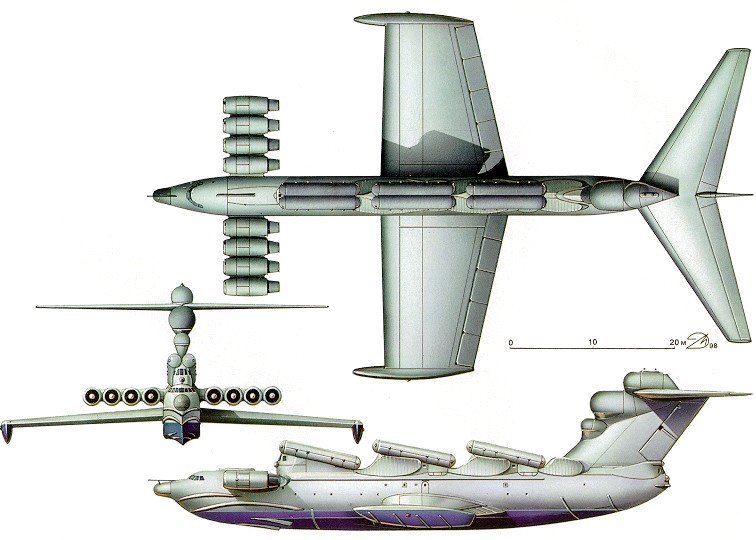
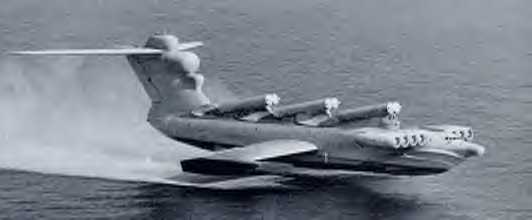
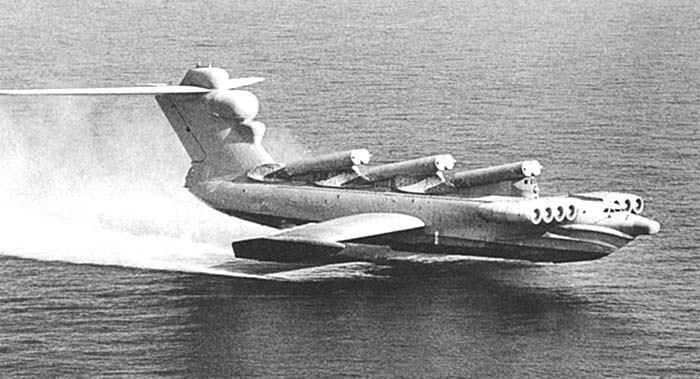
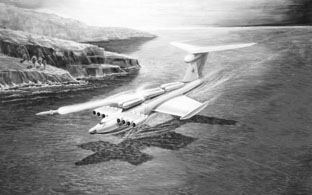
China, a great power in the Pacific, is particularly interested in WIG Air-Mech technology. Chinese analysts attribute the following advantages to WIG craft over conventional ships and aircraft:
--Superb Mobility. A WIG Air-Mech craft travels above the water's surface to travel in the air whose density is 800 times less than that of water. This greatly decreases the drag exerted on ordinary vessels and greatly increases its speed. Fast transports have a top speed of 20 knots. A conventional warship has a maximum speed of 30 to 40 knots, and although the hulls of hydrofoil craft and hovercraft travel above the water, their hydrofoils and their aprons still come in contact with the water. Thus their speed is limited to between 70 and 80 knots or less. But a WIG Air-Mech craft can travel between 300 and 400 knots.
--Superb Airworthiness. A WIG craft can fly around bad weather or fly above a stormy sea. Since a WIG craft is not pounded by the storm waves it is remarkably seaworthy. It is also very airworthy.
--Ease of Operation. A WIG craft is controlled through its vertical rudder, its elevator, and its wing flaps. It is simpler to fly than an airplane, and it turns easily. The WIG craft's speed and altitude are easily controlled by the flaps.
--Economical operation. Pressure under the wings of a WIG craft increases greatly by flying fairly close to the water surface. Consequently, only 80 to 130 horsepower are required to propel each ton of weight. The large lift-drag ratio means that fuel-consumption is less and the cruising radius is expanded when compared to similar-sized aircraft. WIG craft are far superior to ordinary aircraft and helicopters in carrying capacity, speed, and cruising radius when using the same power.
--Convenient Maintenance. WIG craft do not need permanent shore bases. Unlike other high-speed craft, they are able to come ashore under their own power and do not need cranes or chutes. Furthermore, since they have no aprons, like hovercraft, maintenance is very convenient. WIG craft do not have to make a gliding takeoff from the water or land on the water like seaplanes. This lessens the corrosive effect of seawater on the hull.
--Diverse Flight Modes. Not only can WIG craft fly quickly and steadily above water, under radar detection but they can also fly above beaches, marshes, grasslands, deserts, glaciers, and snow-covered land.
--Flight Safety. Should the engines fail, the WIG craft can travel on the water like a conventional ship. They are stable craft, which have operated safely over the years. Some WIG craft vent their engine exhaust forward beneath the wings of the craft to create an increase in dynamic lift. This not only assists takeoff and improves amphibious performance, but also improves flight safety.
--Military applications. The speed, maneuverability, amphibious capability, and reduced signature of WIG craft are greater than that of other craft. Their fast, low-altitude approach may allow them to become the next generation of fast attack craft replacing hydroplanes and hydrofoils. Since WIG craft usually fly within 50 meters of the surface, they are in the radar sweep and search blind zone. The ultra-low altitude of WIG craft leaves no traces on the water surface and is difficult to detect by radar. WIG craft are not optically trackable from space like conventional surface ships. This greatly increases the concealment and surprise attack capabilities of the craft. This extraordinary concealment capability has extremely important military significance. WIG craft may be used as Air-Mech landing craft and for the rapid and effective movement of Heavy AFVs, Gavins/Ridgway and M8 Buford AGS Armored Fighting Vehicles and troops in a campaign. The low-flying altitude, the long cruising radius, and the AFV carrying-capacity of WIG craft are second to only ships. WIG craft are also suited for anti-submarine patrol craft, high-speed minelayers, minesweepers, and rescue craft.
Neither Fish nor Fowl
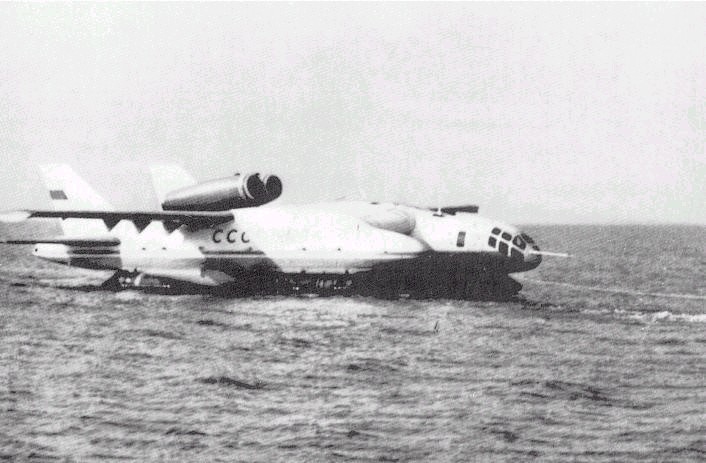
A U.S. Army separate mechanized Heavy Brigade, with all its personnel and equipment, weighs in at 26,649 short tons (69,623 metric tons) and requires 97 x 20-foot containers for conventional shipment.31 This Brigade could be moved on just 11 WIG craft, each designed to move 2,500 tons. An Air-Mech-Strike Brigade will weigh less, but the helicopters take space, so the same number of WIG craft might be needed to move the Air-Mech-Strike Brigade. So, why does the U.S. Armed Forces not have WIG craft to move its Army rapidly where it is needed?
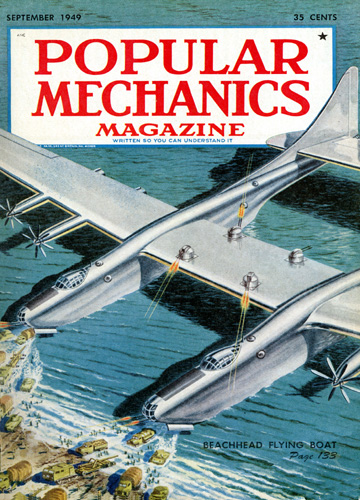
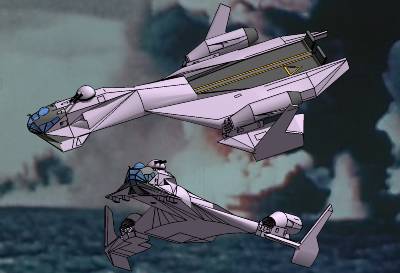
The first issue: is WIG a naval craft or an aircraft? The Navy has not included WIG craft in its future procurement program, probably because there isn't a surface vessel in the entire Navy that can keep up with it. While the Navy did have a long relationship with American seaplane designers from Glenn Curtis to Howard Hughes, the Navy lost interest in seaplane development in the 1950s when it discounted jet-powered seaplanes as a nuclear bomber platform.
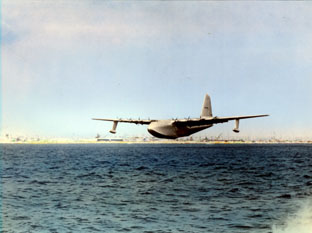
Interest in transport seaplanes began to wane a decade earlier with the abandonment of Howard Hughes H-4 Hercules prototype-- a project designed to enhance strategic deployment capabilities over long distances. There was one flight by Hughes enormous "Spruce Goose" flying boat. On November 2, 1947 it flew at 70 feet over the water for a distance of one mile at a top speed of 80 miles per hour. It was the first and only example of a large-platform WIG mission in U. S. history. Successful WIG development could pose a serious challenge to existing naval platforms because WIG warships would have tactical, technical characteristics far superior to existing surface warship classes and a naval race over the application of WIG technology to warfare at sea could negate capital advantages that the United States Navy enjoys with its current surface combatants.
The Air Force is also not interested and does not procure transport aircraft that can routinely operate off of dirt or water. The Air Force prefers to operate only off of permanent hard stand airfields. The need for rapid strategic deployability, which drove the development of Hughes flying boat, is once again a chief concern for U. S. defense planners and a major consideration in the ability to make the United States Army into a full-spectrum, power projection force.
Since the WIG craft do not fit neatly in either the Navy's or Air Force's "comfort zone" and since the Army is the only service without strategic mobility, perhaps the WIG craft belongs in the Army as part of Army aviation or transportation corps. With WIG craft, the Army could Air-Mech its heavy AFV elements rapidly to the crisis area regardless of the presence or lack of secure ports and airfields. The Army could deploy with full combat power while the Navy and Air Force could continue their traditional Title X roles by providing longer-term logistics support. WIG technology is not new and other countries are adopting it. Who operates the WIG craft is not important--what is that we obtain them to transport Army Air-Mech-Strike forces. It is time for the United States to embrace this WIG Air-Mech technology and provide strategic mobility to its Army.
Conclusion: WIG Can Be a Deployment Enhancement in a Time of Need
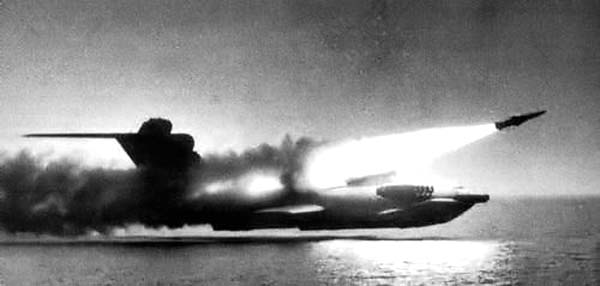
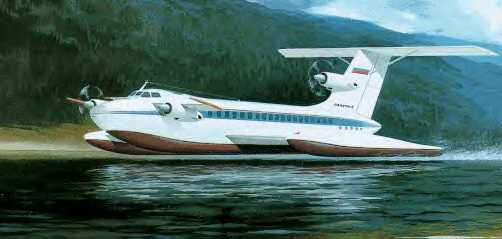
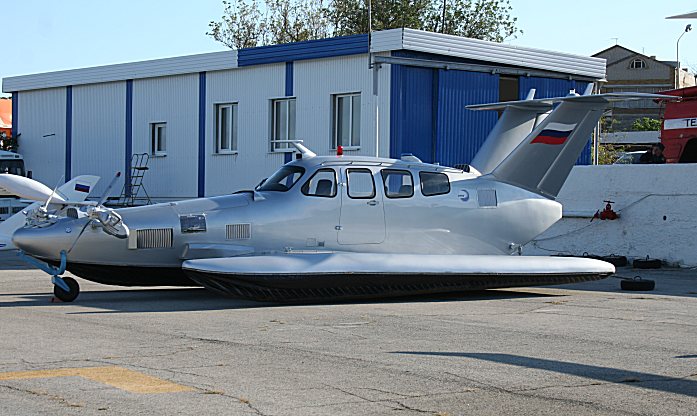
The strategic lift problem will finally be solved when America stops wasting billions on V-22 type gadget planes that can only deliver a squad or two of infantry and obtains WIG craft that can deliver 1000 men and 100 armored vehicles-at-a-time using ground-effect lift technology. This will deliver the heavier M1/M2 type armored vehicles to balance out the light to medium-weight Air-Mech-Strike forces that arrive by C-130/C-17 airdrop/airland or JTR delivery.
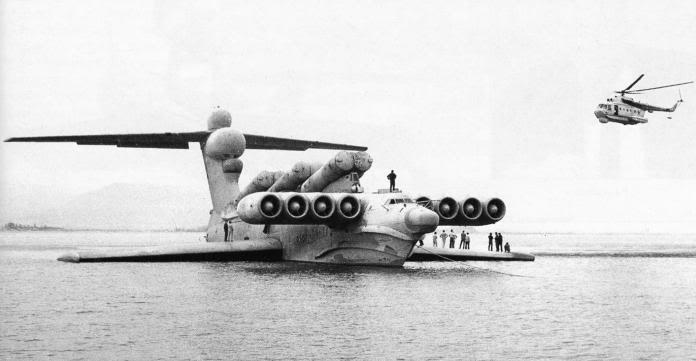
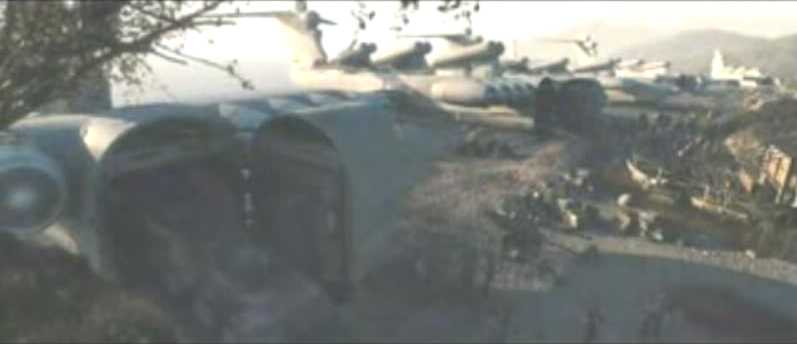
Returning to the issue of overcoming the "tyranny of time and distance" in the Pacific and other theaters, it is very important to note that WIG technology should not be treated as a "silver bullet". But it does represent a potential force-deployment enhancement at a time when the United States retains a wide range of distant commitments and faces the prospect of serious declines in forward infrastructure. Upcoming negotiations with Japan over defense burden- sharing may provide some indications on the probable scope and scale of U.S. defense infrastructure that will be in place at the end of this decade. In South Korea the government has undertaken an expanded defense burden under the assumption that it must prepare for the inevitable withdrawal of U.S. forces from Korea. This comes at a time when the North Korean regime seems to have stabilized its domestic situation and continues to pour resources into its military establishment a point made by General Thomas A. Schwartz, CinC United Nation Command/Combined Forces Command and Commander U.S. Forces Korea, in his recent testimony before the Senate Armed Services Committee.35 Recent increases in the People's Republic of China's Defense Budget and greater stridency over the issue of Taiwanese independence have gone hand-in-hand with a developing arms race in Asia and point to prospects for conflicts in the region.36 When the destabilizing developments in the Indian Ocean are added, the requirement for the United States Army to overcome the "tyranny of time and distance" and be the cornerstone of U.S. power projection in the Pacific becomes apparent. There are compelling reasons for a second century of American presence in the Pacific and elsewhere. WIG might just Air-Mech get us there.
WIG Airborne Aircraft Carriers?
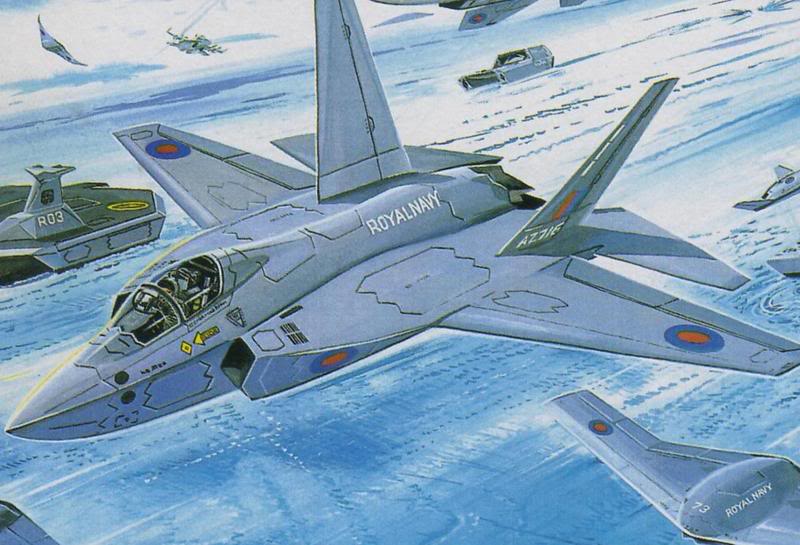
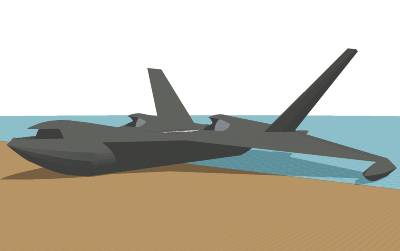
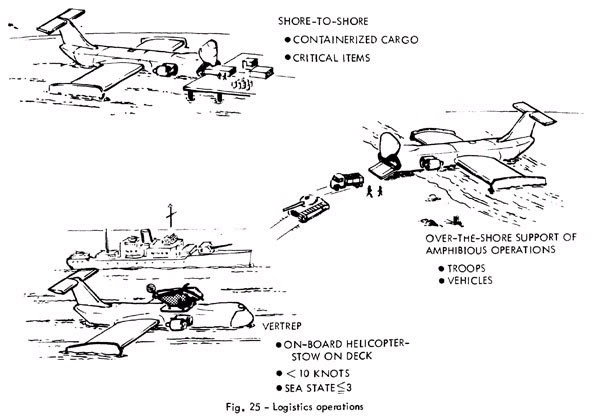
The surface ship is increasingly untenable as a platform of war exposed as it is on the surface of the water to all manner of guided and unguided High Explosive weaponry. Even in WW2 anything under 10, 000 tons was extremely vulnerable to UNguided munitions. If containerships and oil trankers are going to be escorted safely across the seas, we must blanket the skies with friendly aircraft to keep enemy missile, torpedo and sea mine launchers at bay. WIG seaplanes would be ideal to hunt enemy submarines as well as launch & recover their own seaplane fighters--modernized SeaDarts that can also land on the water and be operated by any ship with a crane--or the F-35B STOVL from the top of the WIG's fuselage.
Details: Airborne Aircraft Carriers
Of course, piggy-back-mounted fighters can launch and escort the U.S. Army AMS maneuver force so its "MECHANDOs" can land on the beach and rumble ashore in their high-technology M113A4 Gavins...
 James Bond 007 Retro-Novel Devil May Care by Sebastion Faulks features the Russian WIG Caspian Sea Monster!
James Bond 007 Retro-Novel Devil May Care by Sebastion Faulks features the Russian WIG Caspian Sea Monster!

